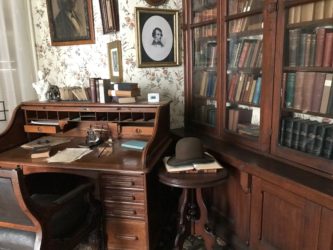
Manson Whitlock, often described as America’s oldest typewriter repairman, passed away in Bethany, Connecticut in August 2013 at the age of 96. He began repairing typewriters in 1930 in his father’s New Haven bookstore and continued in this profession until a few months before his death. His obituary in the Washington Post notes several of his prominent clients, including authors William Manchester, Robert Penn Warren, and Archibald MacLeish.
For decades, Manson Whitlock repaired typewriters for students and professors from nearby Yale University. The New York Times Magazine noted that he “fixed more than 300,000 of them over the course of his life.”
Today, dusty typewriters more often stand in store window displays or in people’s storage lockers or garages than on their individual desks. They have become yet another relic, still honored by the generations who reminisce about their typing days of long ago, as well as by younger folks who have never touched a typewriter key. Like the vintage sewing machines found in the windows of an All Saints store, typewriters evoke memories of a long past craft and activity.
In Populaire, a 2012 French film written and produced by Regis Roinsard, a young woman secretary from Normandy wins a national speed-typing contest in the late 1950s, transforming her into a national celebrity. Such an endeavor, while highly unlikely to have happened even 60 years ago, is unimaginable today. Yet for decades, a certain level of typing speed was required for applicants seeking the job of secretary.
There are still holdouts of people who love their typewriters. The late Herb Caen, beloved columnist at the San Francisco Chronicle, wrote his columns on his loyal Royal(s), one of which is on permanent display in the San Francisco Main Library.
In an August 2013 New York Times Opinion piece (I Am TOM. I Like to TYPE. Hear That?) actor, producer, writer Tom Hanks writes “I am well versed in the focus-stealing racket one can make with a vintage manual typewriter. I use a manual typewriter — and the United States Postal Service — almost every day.” His description of the feel and sounds of various models of typewriters is enough to make most anyone want to go in search of one of these amazing classic machines.
But in a world no longer inhabited by Manson Whitlock, who will repair all of those typewriters?





Gardner
22 Apr 2014Dear Marcia,
If other readers should ask you to do an article about modern (after WWII) typewriters that
can be used for travel or in a house where there is no electricity; some makers could be:
Olympia
Olivetti Lettera 32
Adler
Hermes
Jean Farrington
23 Apr 2014In my day, when you went off to college, a common graduation gift was a typewriter and often, a manual one. My grandparents gave me a Facit manual typewriter; it was made in Sweden and supposedly my grandfather had researched what would be a good brand. Maybe he just liked the oddity of a make no one had ever heard of. But, using the power of Google, I discovered that it was considered a “princely typewriter” (http://oztypewriter.blogspot.com/2011/10/facit-tp1-portable-prince-of.html) and designed by a real prince. In any case, it served me faithfully throughout my undergraduate years for many an English, philosophy or psychology course paper. In graduate school I upgraded to an early Radio Shack TRS 80 computer complete with floppy disks. Remember those? But I hung on to the typewriter for many, many years..
Marcia Schneider
24 Apr 2014What a good looking typewriter. Definitely a prince of a typewriter, although I did enjoy my Smith Corona.
Marcia Schneider
24 Apr 2014Hermes? Does it come with a silk scarf?
Sandra
24 Apr 2014Aaah yes. A hundred years ago when I went off to college I received a Royal typewriter. It was dark pink, very pink. I haven’t thought of it for those hundred years. It made me smile. Thanks.